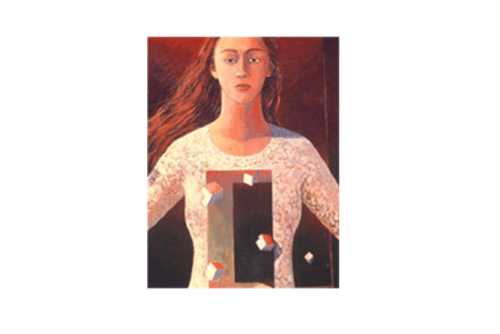Mapping Spaces and Places
Artists such as Annie Pootoogook disrupt a whole discourse of earlier colonialist artistic representations of the Arctic to restage, and in some sense mock, the aesthetics and politics from which those original representations are drawn. Pootoogook, like Isaac Julien, also makes us rethink the Arctic in a fairly over-the-top way, through drawings that depict somewhat unsettling social interactions between Inuits in domestic settings in Cape Dorset in Nunavut. Rather than focusing on the landscape, Pootoogook turns her back on the beautiful yet desolate Baffin Island where she lives, and instead focuses her attention on fairly mundane and ordinary interiors and aspects of everyday life. This everyday life includes depictions of Western food from the new Co-op Food Store and the availability of television and broadband. While many families sleep in tents in nice weather, Pootoogook’s drawings focus on the interiors of “southern style” three-bedroom houses, and her work makes us think of the Arctic as a welfare state in Canada.
Anne Noble grew up hearing about Antarctica and reading about it almost daily in the New Zealand press. Her map series reflects the infiltration of Antarctic representation into the ways she imagines the earth as a whole. For Noble, the mapped Antarctic seeps into all sorts of strange and surprising locations: the bottom of a cheap plastic blow-up globe, the south pole the ball’s “bung;” a decoration on a CD marketing the continent. Are these forms of seeing Antarctica as an innocent diversion, decorative, instructional, or something else? Noble chooses a portrait mode with a blackout background for some of the images. For others she emphasizes the materiality of the paper of the original map. Some maps seem more sinister now; it is impossible not to view the 1955 British Petroleum map of the South Pole as a board game, separately from the renewed press to extract fossil fuel from ice, even though the Antarctic Treaty in 1959 protected the continent from interests like BP. Other maps in the series are site-specific and include the blurred shapes of museum-goers, themselves often caught capturing the representations of Antarctica on cameras and cell phones. Are these maps or power? Or powerful maps? Whatever territory they point to, it is unsettled and unsettling.
The Argentinean multi-media artist Andrea Juan comes from a nation that includes its Antarctic territories in insets on national maps. Juan’s colorful projections confuse the common separation of map and territory by overlaying her mapped projection onto the territory. The discordant colors and the showy hyper-feminine patterns projected on an iceberg play with ideas of culture versus nature, and with the classic concept of Antarctica as a blank page to be filled in—this time by a fanciful, degraded (feminized) form of culture. Juan questions which culture should be making a place of Antarctic space. Should that place be instrumental? What’s wrong with a little prettification of the blank, especially if the “painting” technique of light projection, as Juan’s ecofeminist principles require, leaves no permanent trace?
Connie Samaras’ photographs, on the other hand, bring us down to earth by focusing precisely on those traces, particularly buildings and construction. Her aesthetic approach invites us to see Antarctica as a gritty corporate environment that is not quite a rooted place but more of a transit zone set in a sublime landscape. As her artist’s statement makes clear, she shows us the remains of buildings from an earlier, more utopian era. She also documents the construction of new buildings that suggest a future more corporate than utopic. The current wave of globalization may be one of world cities, and Samaras’ photographs show that Antarctica is not separate from this world. But, she also makes us doubt that global interconnection necessarily points us toward peaceful interrelation.
Placing Antarctica into a global frame is also the project of An-My Lê, whose series of photographs, Events Ashore, depicts operations on U.S. military bases throughout the globe. By including U.S. bases at McMurdo Station and the South Pole in Events Ashore, Lê de-exceptionalizes Antarctica and connects it as a place within global economies of power. She records a built environment that is brutally industrial, menacing, and yet strangely familiar. While her large format images monumentalize the massive effort to support scientists in Antarctica, it also points to the anxiety of colonization for science, in tension with the growing trend toward remote, modeled, or robotic modes of information gathering. The glorification of labor and the working class aspect of the South Pole site gestures complicatedly to the impossibility of a nostalgia for human survival. Lê’s South Pole is a combination (post) industrial office park and (de) militarized base. The support of science requires an infrastructure whose implications secures Antarctica within a map of globalization and capital flows at odds with depictions of the ice as pure, empty, or even as heroic and sublime.
The impact of building an industrial empire is also at issue in the Arctic. New oil drilling, as well as the vast increase in ship traffic, is having an effect on local Inuit populations, the environment and wildlife in the region, and is leading to a reappraisal of Arctic international law and practice. As both poles face a speeded-up version of industrialization, and the Antarctic is everyday more open to scientists and tourists, it is crucial to think knowledgeably, as well as critically, about regions in which so many vital U.S. and global concerns revolve. The circumpolar world is now a transformed geographical reality and a geopolitical force to be dealt with. As a result, there is a greater need now for anti-colonial and feminist work on these regions than ever before.


